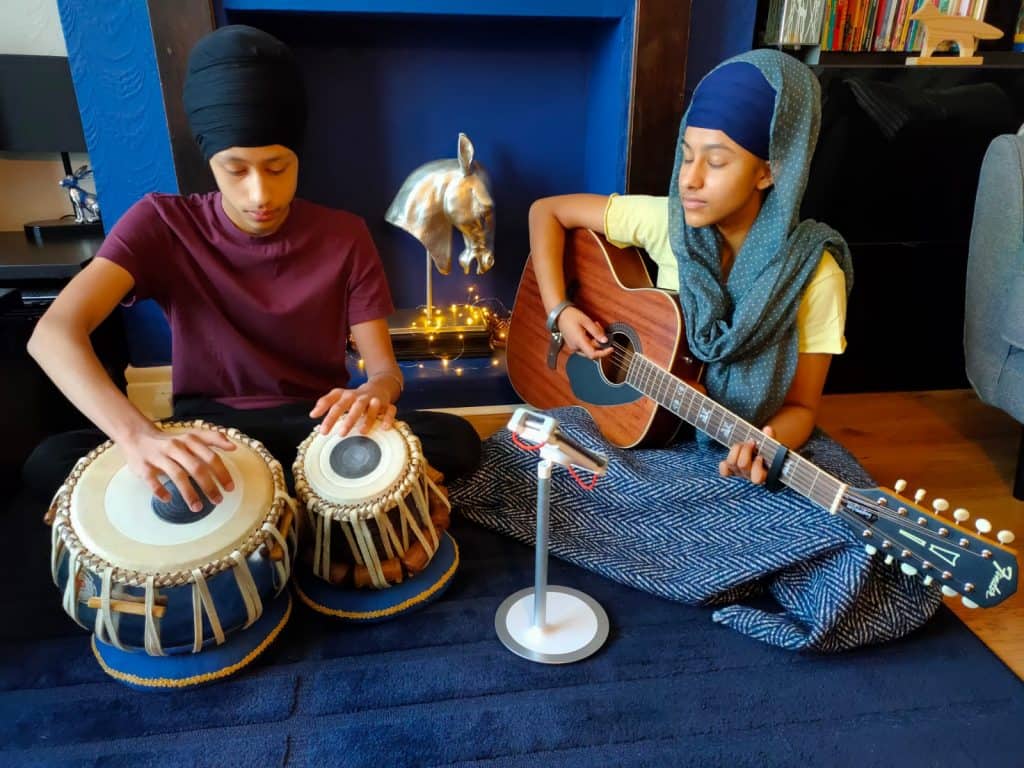By Minreet Kaur
When lockdown started in March, many schools shut and exams were cancelled. It was a shock to the system for some children who felt they had nothing to do.
However, Har-Rai Kaur, 18, and her brother Jaap Singh, 16, woke up with an idea: performing kirtan — Sikh hymns from the holy scripture — from their east London living room.
The Sikh Gurus proclaimed kirtan as a divine method for the human soul to re-emerge with God, if the devotee sings the melodies with their heart closely focused on the meaning and true spirit of the Gurbani, words of the gurus.
Guru Granth Sahib, the holy scriptures of the Sikhs, is compiled in ragas (melodies) and taal (rhythmic beat patterns). There are 31 ragas and 17 taals within the Guru Granth Sahib, which form the basis of kirtan musical compositions.
The Sikh tradition of kirtan was started by the founder, Guru Nanak Dev Ji, at Kartarpur, in what is now Pakistan, in 1521, and strengthened by all the nine succeeding gurus. Kirtan is such a huge part of the Sikh institution that in spite of massacres and battles that almost wiped out the Sikh faith, the place of kirtan was assured, to be continually performed within the gurdwaras to uplift souls.
Initially Har-Rai and Jaap’s father used his smartphone to film a clip to send to their grandparents. He then uploaded it onto social media and when a friend said “they were looking forward to another kirtan clip tomorrow”, the idea of kirtan from the living room was born.
Har-Rai and Jaap set up a Facebook and Instagram page called Living Room Kirtan to share Kirtan with their friends and relatives whom they could no longer meet during lockdown. Since then they have managed to post a new shabad (Sikh hymn) every day, connecting with sangat (the congregation) across the world.
It has given them a focus and purpose for the lockdown period while connecting with sangat. Even though they cannot see them, they say they can feel their presence in their living room.
Parents Mankamal Singh, 47, and Devinder Kaur, 46, who live in Ilford, said: “It’s a proud moment for any parent of faith to watch their children growing into ambassadors of their faith and culture. Har-Rai and Jaap started to fill a void that was created by the sudden Covid lockdown. The project became a blessing and reached out to Sikhs across the globe every day. Over 108 days on, we can see how the whole experience is shaping them as very proud young Sikh adults in today’s diverse world.”
Every day they would recite a new shabad and post on social media. The plan was to do it for 108 days as this would mean they completed one mala, a string of 108 prayer beads. On the final day came Guru Nanak Dev Ji’s beautiful message, which starts:
My desire has been fulfilled — my friend has come to my home.
At the union of husband and wife, the songs of rejoicing were sung.
Har-Rai sings the shabads, usually accompanying herself on guitar, but sometimes on vaja — a harmonium — and Jaap plays tabla.
The shabad and English translations with the videos are posted online so that anyone can sing along at home and understand. This has helped the community to feel connected, the response has been very positive and it has encouraged them to sing and connect with God more.
Londoner Everton Bahadur Young, 59 said: “I cannot begin to give enough thanks for the incredible events and happenings that have occurred during this so-called lockdown. One of those blessings is what you’ve all achieved.”
Har-Rai and Jaap hope to carry on posting online regularly and, when safe, to take part in events at gurdwaras.

















